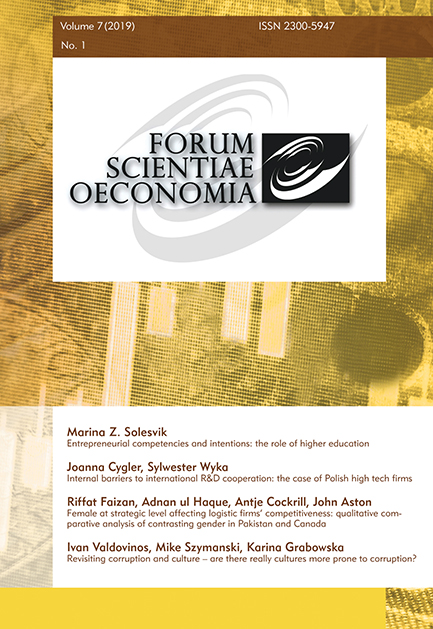Females at strategic level affecting logistic firms’ competitiveness: qualitative comparative analysis of contrasting gender in Pakistan and Canada
Females at strategic level affecting logistic firms’ competitiveness: qualitative comparative analysis of contrasting gender in Pakistan and Canada
Author(s): Riffat Faizan, Adnan Ul Haque, Antje Cockrill, John AstonSubject(s): Socio-Economic Research
Published by: Wydawnictwo Naukowe Akademii WSB
Keywords: Creativity and innovation; female representation; firm’s competitiveness; gender diversity; leadership style; contrasting economies
Summary/Abstract: Post-World War II, a significant growth in the representation of females in the workforce emerged, reflecting the signifi- cance of the female workforce in the present era. This qualitative research explores distinctive factors associated with female representation at the top levels of cargo logistics firms affecting overall competitiveness and performance in Pakistan and Canada. Earlier research has been of a single dimension and quantitative to a large extent, whereas this study undertakes a multivariate stance by considering leadership style, economies, and gender diversity in a qualitative manner, using networking, connections, and snowball sampling semi-structured interviews conducted with employees at all three levels of management. After a combined 91 (31=strategic level, 28=middle level, and 32=operational level) interviews, we reached the saturation point from which to draw a logical conclusion. The findings revealed that higher female representation at the top levels enhances innovation and the competitiveness of the firms. Gender diversity improves operational efficiency and performance. Males showed a higher preference for structured leadership, while females preferred flexible leadership. Interestingly, females in emerging economies have a higher chance of career advancement. Males are task-oriented and therefore demonstrated a preference for autonomy, while females are people-oriented, and thus showed creativity and concern for others. The original contribution of this study is that it enhances the body of knowledge by offering a qualitative in-depth understanding of the relationship between variables from a multi-dimensional perspective, namely gender, management levels and economies of interest, within one research framework.
Journal: Forum Scientiae Oeconomia
- Issue Year: 7/2019
- Issue No: 1
- Page Range: 57-71
- Page Count: 15
- Language: English

